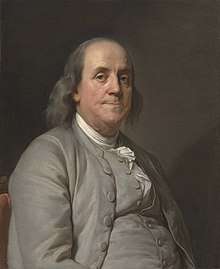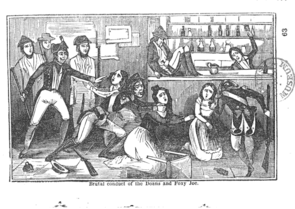Associators
| Associators | |
|---|---|
 The U.S. Army 111th Infantry Regiment Pennsylvania Army National Guard's 56th Stryker Brigade Combat Team, 28th Infantry Division nicknamed the "Associators" use the unit insignia of an associator volunteer, one of the few surviving contemporary examples of the associator legacy of early colonial Pennsylvania | |
| Active | 1689-1784 |
| Country |
|
| Allegiance |
|
| Branch | colonial militia, independent volunteers, military association, refugees, partisans, (auxiliary troops) |
| Type | infantry, dragoons (mounted infantry), artillery |
| Size | company-regiment |
| Engagements |
Maryland Protestant Rebellion (1689) King George's War (1744-1748) French and Indian War (1754-1763) American Revolutionary War (1775-1783) |
| Commanders | |
| Notable commanders |
|


.jpg)



Associators were members of 17th and 18th century, volunteer, military associations, in the British American Thirteen Colonies and British Colony of Canada, more commonly known as, Maryland Protestant, Pennsylvania, and American Patriot and British Loyalist, colonial militias. Associators unlike militia were military volunteers exempt from regular mandatory military service. Other names used to describe associators were "Associations", "Associated", "Refugees", "Volunteers", and "Partisans". The term, "Non-Associators", applied to American colonists, who refused to support and sign "military association" charters, were not affiliated with associators, or would choose instead, to pay a fine and suffer possible retaliation. It is rumored that during the American Revolutionary War, some associator units operated more like or were loose-knit criminal gangs. The present-day U.S. Army 111th Infantry Regiment Pennsylvania Army National Guard's 56th Stryker Brigade Combat Team, 28th Infantry Division is nicknamed the "Associators" helping to preserve the volunteer associators ancestral legacy in Pennsylvania.
Maryland Protestant Associators
Philadelphia and Pennsylvania Associators
During King George's War, Benjamin Franklin, in 1747, wrote and published the pamphlet, Plain Truth, calling for a voluntary association to defend Philadelphia. This was in line with his earlier formation of volunteer fire-companies. This organization was formed and approved by the Council and the officers would be commissioned by the Council President.[1] The U.S. Army 111th Infantry Regiment Pennsylvania Army National Guard's 56th Stryker Brigade Combat Team, 28th Infantry Division nicknamed the "Associators" traces their lineage to these ancestral Pennsylvania Associators. In 1755 these groups were re-established in response to Braddock's Defeat.[2]
Associators in American Revolutionary War
American Patriot Associators
State of Pennsylvania
In 1776, Pennsylvania, Patriot, volunteer, military groups, in the tradition of earlier, colonial, associator militias, used the name the Pennsylvania Associators and in 1777, were renamed the Pennsylvania State Militia.
- Hanover Associators (1774)
- Bucks County Associators (1775-1776)
- Lancaster County Associators (1775)
- Northumberland County Associators (1776)
- Artillery Battalion, Pennsylvania Militia (Philadelphia) (1747)
- 4th Battalion of Philadelphia County Militia (1776)
- Philadelphia Brigade of Militia (1747)
- 2nd Battalion, Philadelphia Associators
- 3rd Battalion, Philadelphia Associators
British Loyalist Associators
Many Loyalist irregulars who fought with the British in the American Revolutionary War were "associators". These units were sometimes commissioned by the commander in chief but could also be commissioned by the commander of a garrison or a royal colonial governor. They received no pay, and often no uniforms; they were usually issued provisions, but relied on labor or looting to earn money. Loyalist Associators often served in mixed-race units, composed of whites, escaped slaves, and even American Indians.
Perhaps one of the most famous Loyalist associators was Colonel Tye, a former slave and leader of the infamous "Black Brigade". He was the first known black officer in North American military history.
Province of Georgia
- Augusta Associators (Augusta) (1781)
Province of Massachusetts
Province of Maryland
- Maryland Royal Retaliators (raised in Philadelphia) (1780-1781)
Province of New Jersey
- Associated Loyalists (also, known as Governor Franklin's Associated Loyalists) (1780-1782)
- Black Brigade[3][4][5] (Black Loyalists) led by Colonel Tye and later, Colonel Stephen Blucke) (Monmouth County) (1779-1783)
- King’s Militia Volunteers[6][7][8] (Monmouth County) (1779-1780)
- Pine Robbers (outlaw gangs) (New Jersey Pine Barrens) (1776-1783)
- Refugees (unit of New Jersey Royal Governor William Franklin's Associated Loyalists and Pine Robbers gang) (New Jersey Pine Barrens), (Ocean County) (1780-1782)
Province of New York
- Associated Refugees (also, known as the King's American Regiment) (Long Island) (1776-1783)
- Brant's Volunteers (New York) (1777-1779)
- De Lancey's Refugees (also, known as "Cowboys" and part of De Lancey's Brigade) (Long Island) (1776-1783)
- Hatfield's Company of Partisans[9] (partisans irregulars led by Captain Cornelius Hatfield, and part of the New Jersey Volunteers (Skinner's Greens) (Long Island) (1779-1782)
- Hazard's Corps of Refugees[10][11][12] (Long Island) (1780-1782)
- Loyal Refugee Volunteers[13][14][15][16][17] (Albany) (1779-1782)
Province of Pennsylvania
- Doan Gang (outlaws) (Bucks County) (1774-1783)
Province of Rhode Island
Other Loyalist Associators
Notable Associators
See also
References
- ↑ Newland, Samuel J. The Pennsylvania Militia:Defending the Commonwealth and the nation, 1669-1870 Commonwealth of Pennsylvania, Dept. of Military and Veterans Affairs (2002)pp36-45
- ↑ The Pennsylvania magazine of history and biography, Volume 26. Retrieved Feb 27, 2010.
- ↑ name = "Newland">Newland, Samuel J. The Pennsylvania Militia:Defending the Commonwealth and the nation, 1669-1870 Commonwealth of Pennsylvania, Dept. of Military and Veterans Affairs (2002)pp36-45
- ↑ {{|url=https://books.google.com/books?id=arI0HSFXwLkC&pg=PA420 Jonathan D. Sutherland, African Americans at War, ABC-CLIO, 2003, pp. 420–421, accessed 4 May 2010}}
- ↑ name = "The Black Pioneers". Black Loyalists:Our History, Our People. Canada's Digital Collection. Archived from the original on 2007-09-28.
- ↑ {{|url=http://www.royalprovincial.com/military/rlist/rlist.htm List of British Loyalist Associators - The On-Line Institute for Advanced Loyalist Studies }}
- ↑ {{|url=http://www.royalprovincial.com/military/rhist/kmilvol/kmvnot1.htm Index to King’s Militia Volunteers History - The On-Line Institute for Advanced Loyalist Studies }}
- ↑ {{|url= https://books.google.com/booksid=kXDyC76jyisC&pg=PA139&dq=King%E2%80%99s+Militia+Volunteers&hl=en&sa=X&ved=0ahUKEwjtkNyTz_jVAhXJzIMKHY3OCakQ6AEIQjAF#v=onepage&q=King%E2%80%99s%20Militia%20Volunteers&f=false Michael S. Adelberg, Roster of the People of Revolutionary Monmouth County (New Jersey). Baltimore: Genealogical Publishing Company, 1997.}}
- ↑ {{|url=http://www.royalprovincial.com/military/rlist/rlist.htm List of British Loyalist Associators - The On-Line Institute for Advanced Loyalist Studies }}
- ↑ {{|url=http://www.royalprovincial.com/military/rlist/rlist.htm List of British Loyalist Associators - The On-Line Institute for Advanced Loyalist Studies }}
- ↑ {{|url=http://www.royalprovincial.com/military/rhist/hazard/hclist.htm Index to Hazard's Corps of Refugees History - The On-Line Institute for Advanced Loyalist Studies }}
- ↑ {{|url=https://books.google.com/booksid=24stDwAAQBAJ&dq=Hazard%27s+Corps+of+Refugees&source=gbs_navlinks_s David M. Griffin, Lost British Forts of Long Island. Mount Pleasant, SC: Arcadia Publishing, 2017. p. 93.}}
- ↑ {{|url=http://www.royalprovincial.com/military/rlist/rlist.htm List of British Loyalist Associators - The On-Line Institute for Advanced Loyalist Studies }}
- ↑ {{|url=http://www.royalprovincial.com/military/rhist/lrv/lrvlist.htm Index to Loyal Associated Refugees History - The On-Line Institute for Advanced Loyalist Studies }}
- ↑ Todd Braisted, Thomas Ward and the Loyal Refugee Volunteers at Bergen Neck, 1779-1782. 1999.
- ↑ {{|url=https://books.google.com/bookid=PA8AQAAMAAJ&dq=Loyal+Refugee+Volunteers&source=gbs_navlinks_s Alexander Fraser, United Empire Loyalists: Enquiry Into the Losses and Services in Consequence of Their Loyalty. Evidence in the Canadian Claims], Ontario. Department of Public Records and Archives. Ottawa, ON: L.K. Cameron, 1905. p. 654-655.}}
- ↑ James J. Gigantino, The American Revolution in New Jersey: Where the Battlefront Meets the Home Front Rivergate Regionals Collection. Rutgers, NJ: Rutgers University Press, 2015. p. 73, 81, 83, 202, 206.
- ↑ {{|url=http://www.royalprovincial.com/military/rlist/rlist.htm List of British Loyalist Associators - The On-Line Institute for Advanced Loyalist Studies }}
- ↑ {{|url=http://www.royalprovincial.com/military/rhist/lnassoc/lnalist.htm Index to Loyal Newport Associators History - The On-Line Institute for Advanced Loyalist Studies }}
- ↑ {{|url=https://books.google.com/booksid=HmUFAAAAQAAJ&pg=PA286&dq=british+army+arrival+in+newport+rhode+island&hl=en&sa=X&ved=0ahUKEwjKqZaafLVAhXJTCYKHcBIAWUQ6AEIOjAD#v=onepage&q=british%20army%20arrival%20in%20newport%20rhode%20island&f=false Abiel Holmes, The annals of America: from the discovery by Columbus in the year 1492, to the year 1826, Volume 1. Cambridge, UK: Hilliard and Brown, 1829 p. 286.}}
- ↑ {{|url=https://archive.org/details/amloyalists00sabirich Lorenzo Sabine, The American Loyalists; or, Biographical sketches of adherents to the British crown in the war of the revolution; alphabetically arranged; with a preliminary historical essay. Boston: C.C. Little and J. Brown, 1847. pp. 63, 269.}}
- ↑ {{|url=https://books.google.com/books?id=fl0EAAAAYAAJ&pg=PA749&dq=thomas+vernon+loyal+newport+associators&hl=en&sa=X&ved=0ahUKEwjk-7ix8_LVAhXI5CYKHfA8DHkQ6AEIJjAA#v=onepage&q=thomas%20vernon%20loyal%20newport%20associators&f=false Samuel Greene Arnold, 1701-1790 Volume 2 of History of the State of Rhode Island and Providence Plantations. Providence, RI: Preston & Rounds, 1899. p 749.}}
- ↑ {{|url=https://archive.org/details/descendantsoftho03reed William Field Reed, The Descendants of Thomas Durfee of Portsmouth, R.I., Volume 1. Washington D.C.: Gibson Bros., Printers, 1900 p. 207-208.}}
- ↑ {{|url=https://books.google.com/books/about/Biographical_Sketches_of_Loyalists_of_th.html?id=QjUNAAAAIAAJ Lorenzo Sabine, Biographical Sketches of Loyalists of the American Revolution, Volume 3. Carlisle, MA: Applewood Books, 2009. p. 581.}}
- ↑ {{|url=https://books.google.com/books/about/Guide_to_the_Battles_of_the_American_Rev.html?id=KRRSfy7eVoIC Theodore Savas and J. David Dameron, Guide to the Battles of the American Revolution. Savas Beatie LLC, 2006. p. xliii.}}
- ↑ {{|url=https://books.google.com/books?id=Mo4wDQAAQBAJ&pg=PT321&dq=loyalists+in+newport&hl=en&sa=X&ved=0ahUKEwjanMTH9vLVAhVE5CYKHc1HB6sQ6AEILDAB#v=onepage&q=loyalists%20in%20newport&f=false Thomas N. Ingersoll, The Loyalist Problem in Revolutionary New England. Cambridge, UK: Cambridge University Press, 2016.}}
- ↑ {{|url=https://books.google.com/books?id=uR13CQAAQBAJ&pg=PT37&dq=loyalists+in+newport&hl=en&sa=X&ved=0ahUKEwitydTSq_PVAhWKdSYKHfYoBcYQ6AEIWzAJ#v=onepage&q=loyalists%20in%20newport&f=false Christian M. McBurney, Spies in Revolutionary Rhode Island. Mount Pleasant, SC: Arcadia Publishing, 2014.}}
- ↑ {{|url=https://archive.org/details/diaryofthomasver00vern Thomas Vernon, he diary of Thomas Vernon, a loyalist, banished from Newport by the Rhode Island general assembly in 1776. Providence, R.I.: S. S. Rider, 1881.}}
- ↑ {{|url=http://www.royalprovincial.com/military/rlist/rlist.htm List of British Loyalist Associators - The On-Line Institute for Advanced Loyalist Studies }}
- ↑ {{|url=http://www.royalprovincial.com/military/rlist/rlist.htm List of British Loyalist Associators - The On-Line Institute for Advanced Loyalist Studies }}
- ↑ {{|url=http://www.royalprovincial.com/military/rlist/rlist.htm List of British Loyalist Associators - The On-Line Institute for Advanced Loyalist Studies }}
- ↑ {{|url=http://www.royalprovincial.com/military/rlist/rlist.htm List of British Loyalist Associators - The On-Line Institute for Advanced Loyalist Studies }}
- Farrelly, Maura Jane. Papist Patriots: The Making of an American Catholic Identity. Oxford: Oxford University Press, 2012.
- Newland, Samuel J. The Pennsylvania Militia: Defending the Commonwealth and the nation, 1669-1870. Commonwealth of Pennsylvania, Dept. of Military and Veterans Affairs, 2002.
- Ryan, William R. The World of Thomas Jeremiah: Charles Town on the Eve of the American Revolution. Oxford: Oxford University Press, 2010.
- Seymour, Joseph. The Pennsylvania Associators, 1747-1777. Yardley, PA: Westholme Publishing, 2012.
- Verenna, Thomas. "Explaining Pennsylvania's Militia", Journal of the American Revolution, June 17, 2014.
- List of British Loyalist Associators - The On-Line Institute for Advanced Loyalist Studies
External links
- History of (Pennsylvania) Associators and the Military Association 1775-1777 - The Associators of the Revolution
- Pennsylvania Associators, 1747-1777 - (Facebook)
- List of British Loyalist Associators - The On-Line Institute for Advanced Loyalist Studies
- "Loyalist Muster Rolls" Revolutionary War Oaths of Allegiance and Non-Associators